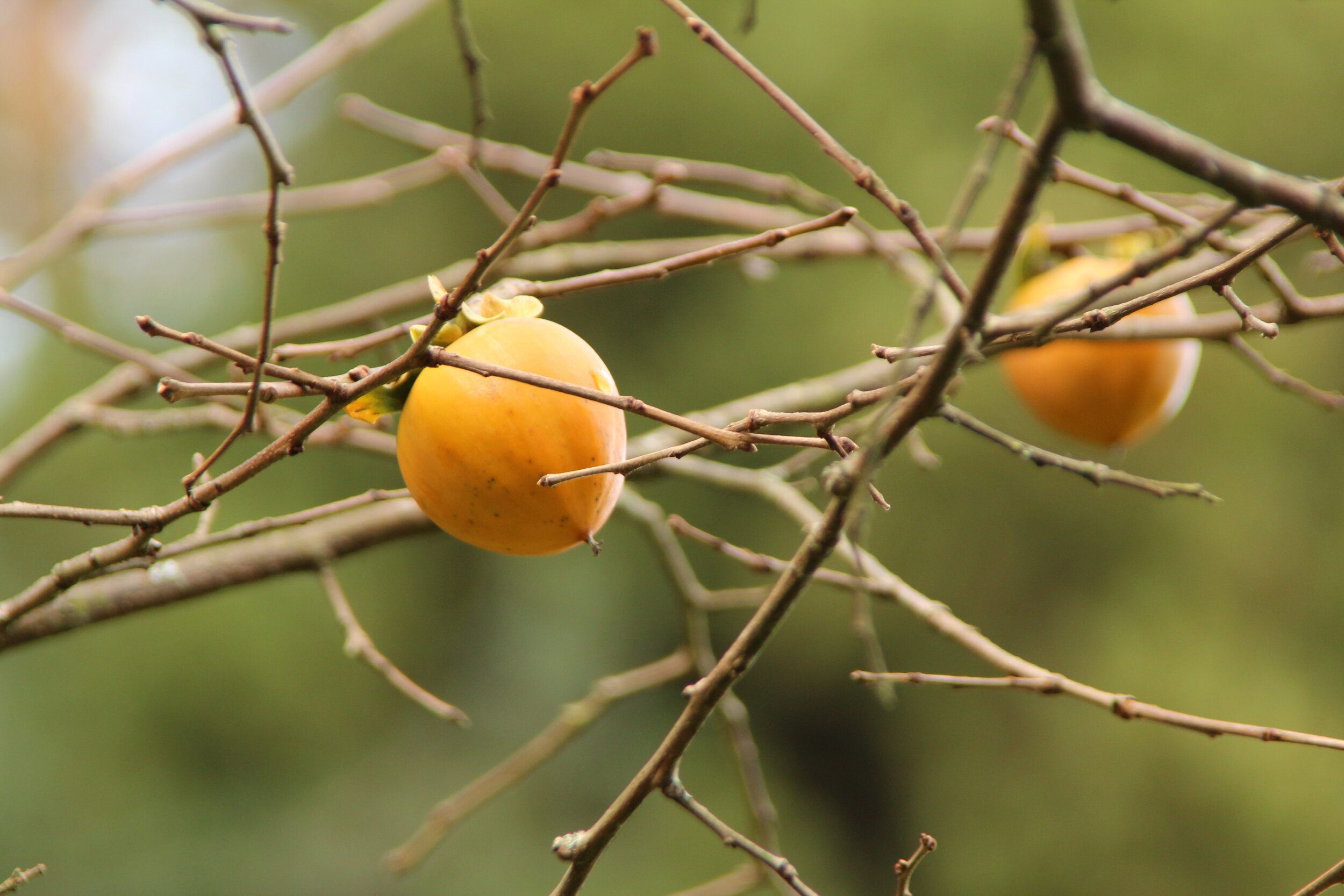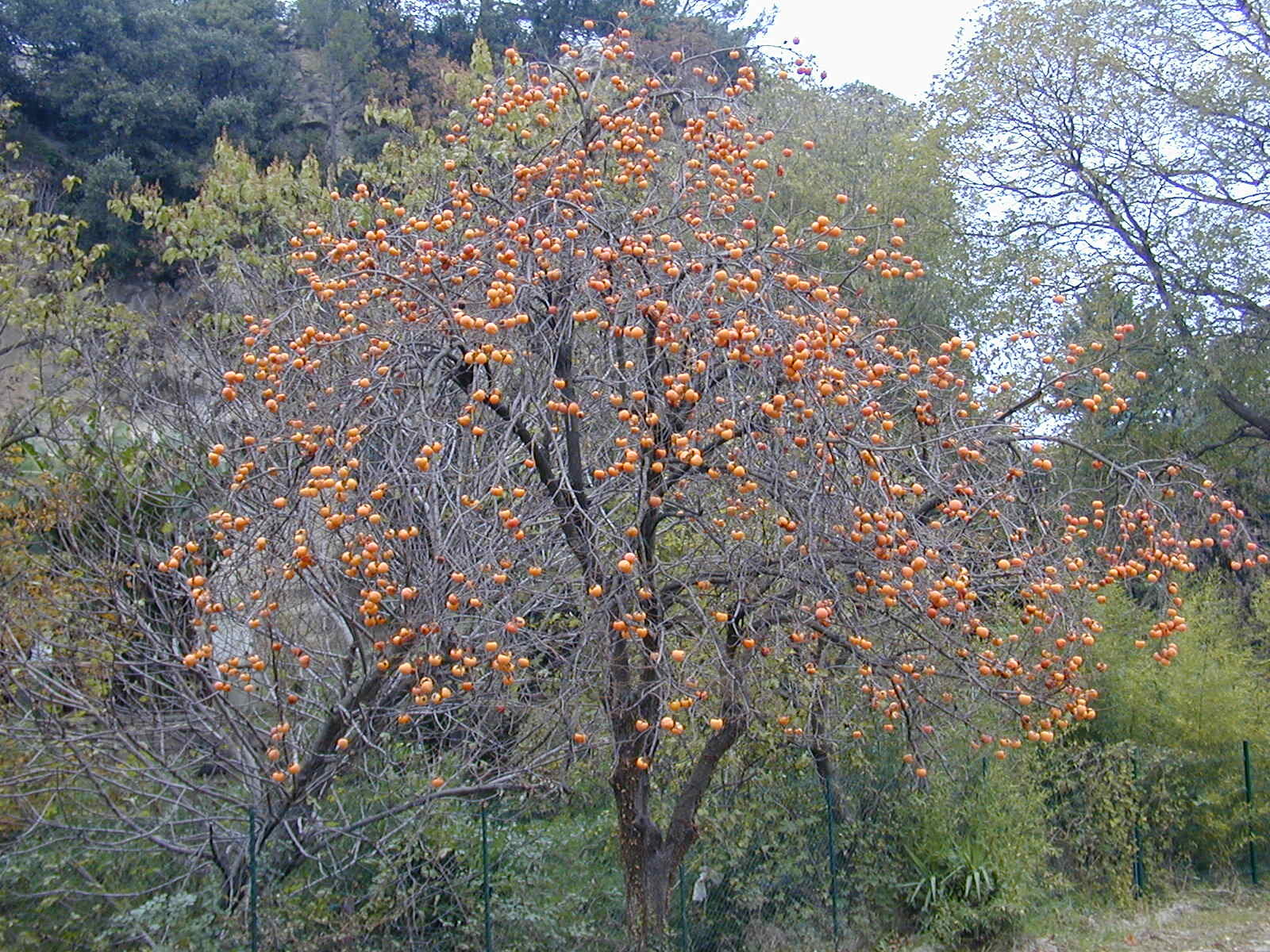Persimmon: The Divine Fruit of Autumn
By Corinne Kennedy
The beautiful autumn fruit of Diospyros kaki in the Seattle Japanese Garden. (photo, Mary Ann Cahill)
This old village –
not a single house
without persimmon trees
Basho
Diospyros kaki is a deciduous tree native to China that was taken to Japan and Korea many centuries ago. Its fruit has been an important food in all three countries – and is now, according to one authority, the world’s major fruit. Common names include Chinese persimmon, Japanese persimmon, oriental persimmon, and kaki (柿). As suggested by the above haiku, trees were widely planted in Japan and central to the lives of its people. We’re fortunate to have two trees in the Seattle Japanese Garden, the larger one located west of the pond in the garden’s orchard area.
Botanical names consist of two words – genus + species. The genus name Diospyros is derived from the Greek words dios (divine) and pyros (grain or wheat) – hence persimmon is the “divine fruit” or “wheat of Zeus.” Kaki, its Japanese name, was chosen to be the tree’s species name (botanically, its “specific epithet”). Although Diospyros kaki is a tree of temperate climates, most of the approximately 200 species in the genus are tropical or subtropical trees. Another temperate species, D. virginiana, is native to the Eastern U.S.; historically, its fruit was an important food. The English common name is derived from the Algonquin language, in which the word persimmon means “dried fruit.”
Diospyros kaki is the species of persimmon most widely planted throughout the temperate world. The wild trees native to China had fruit that were small, astringent (bitter), and very seedy. Over the centuries hundreds of cultivars (cultivated/garden varieties) with superior fruit were developed in China – and later, beginning about 1000 years ago, in Japan and elsewhere. Rich in calories, fiber and vitamins A and C, persimmons were an important food source and became one of Japan’s best-loved trees. The improved “garden varieties” were probably developed not only from chance seedlings with larger and better-tasting fruit, but also from intentional crosses of those improved forms. Fruits are relatively large, smooth-skinned and glossy – in tones of yellow, orange or reddish-orange, depending upon the cultivar.
There are two basic kinds of Chinese/Japanese persimmons – determined by whether their fruit is astringent or non-astringent. Astringent fruits, known as shibugaki, are often described as somewhat oblong or acorn-shaped. Eaten raw, they’re very bitter and unappetizing, but there are several methods used to make them palatable. The easiest way is to let the fruits ripen completely until they’re very soft and jelly-like – and eat them with a spoon. Other methods include treating the fruits with alcohol or dry ice, soaking them in hot water, or freezing them until their texture is like that of sorbet.
The delicacy hoshigaki is made by hanging perimmons in the sun to dry. (photo: Sakurai Midori, Creative Commons Attribution-Share Alike 2.1 Japan license)
The traditional and most important method for removing bitterness is to peel astringent fruit and hang them to dry in a sunny location. The dried product, known as hoshigaki, keeps much longer than the raw fruits. Although vitamin C is lost, hoshigaki is much higher in calories – and historically was very important in winter, when many foods were not available. Associated with good luck and longevity, it was also used in traditional New Year’s celebrations and decorations. Japanese Hawaiians, for example, serve it as a symbol of transformation, signifying health and success in the New Year. Sweeter than sugar, hoshigaki is also used to make traditional Japanese sweets (wagashi).
The fruits of non-astringent persimmons (amagaki) are not bitter. They are said to resemble a very small pumpkin or a flattened tomato. They can be eaten raw like an apple, while they’re still firm and crisp, and are also used in various kinds of sweet and savory dishes. They’re believed to have arisen originally as mutations of the original wild, astringent trees.
Persimmon fruit, leaves and wood have long been important raw materials in Japan. Kakishibu, a brown liquid derived from unripe fruit, is used as a wood stain and sealant, in paper-making, and as a medicine. The leaves, high in tannins and vitamins, were believed to aid digestion, and used to make a tea. In addition, because tannins inhibit bacterial growth, the leaves are used to wrap foods – for example, kaki-no-ha, a traditional type of sushi. Persimmon’s hard wood is used in construction – and for making furniture, implements, and decorative items. The trees are planted in gardens as windbreaks and as attractive ornamentals.
Diospyros kaki with autumn fruit. Languedoc-Roussillon, France. (photo: Semnoz, Creative Commons Attribution-Share Alike 3.0 Unported license)
According to the California Rare Fruit Growers organization, Diospyros kaki does best “in areas that have moderate winters and relatively mild summers – suitable for growing in USDA Hardiness Zones 7 to 10. It can tolerate temperatures of 0 degrees F when fully dormant… [but] the leaves are killed by 26 degrees F when growing.” Because it breaks dormancy based on heat units, not chilling requirements, gardeners in the Pacific Northwest may experience two distinctly different problems. Trees may break dormancy in winter during early warm spells, and then be damaged by later spring frosts. In our climate, on the other hand, with its historically cool springs and summers, a newly planted tree may not break dormancy until summer. Climate change may make this a less likely scenario.
D. kaki grows best in moist, well-drained soil in full sun – and in the Pacific Northwest, a warm microclimate. At maturity, it forms a rounded tree about 20 feet tall and wide, with an attractive branching pattern, but can be kept smaller with judicious pruning. Dwarf cultivars are also available. Kaki, in fact, is one of the easiest fruit trees to grow, with few pest or disease problems. It’s also one of the best fruit trees to plant as an ornamental.
In the U.S., the cultivars most often grown commercially are ‘Hachiya’ (astringent) and ‘Fuyu’ (non-astringent). ‘Hachiya’ fruits are teardrop-shaped; those of ‘Fuyu’ resemble a round and flattened orange tomato. Both are described as beautiful trees, with graceful canopies, and both trees are generally available from retail or internet/mail-order sources. ‘Saijo’ (astringent) bears consistently, and is cold hardy to -10 degrees F. With fruit considered the most likely to ripen in western Washington, it’s often recommended for planting here.
Chinese/Japanese persimmons have small, inconspicuous flowers that appear in summer. Trees are usually either male or female, but some trees have both flower types. In either case, they do not require a pollinizer. The glossy, dark green, leathery leaves are held alternately on their stems. Oval-shaped, they are widest in the middle, with pointed tips. Their autumn colors – yellow, orange and red – complement the ripening fruits. After leaf fall, the fruits remain showy and persist until winter if they aren’t harvested.
Bird perched on a persimmon branch; Japanese woodcut print. (Keiben Matsumura, 1892; Japanese Prints & Drawings, Library of Congress)
In addition to its usefulness, Diospyros kaki holds an important place in Japanese culture and art – including poetry, paintings, prints and ceramics. It’s strongly associated with the autumn season in Japan – a country mindful of seasonal changes, where even foods have important seasonal connotations. “Season words” (kigo), for example, are central to all haiku poems. With its showy autumn fruiting, kaki (persimmon) is a seasonal icon and a beloved autumn kigo. [Note that although persimmon is most closely associated with autumn, its buds, leaves and flowers are sometimes used as spring and summer kigo.]
This 19th century poem is one of Japan’s most famous and beloved haiku:
Biting into a persimmon
The great bell tolls
– Horyuji Temple
Masaoka Shiki
In autumn, the momentary pleasure of tasting a persimmon is contrasted with the ancient temple of Horyuji, the oldest extant wooden building in the world, and the tolling of its great bell.
I’m grateful that Diospyros kaki, a tree so important in the history and culture of Japan, is planted in our Seattle Japanese garden. Attractive throughout the seasons, it’s the only tree in the garden’s orchard area with large and showy fruit. Spring’s pale green leaves mature to a deeper green in summer, then transform in fall into a blend of oranges and yellows. Even after all the leaves have fallen, the vivid yellow-orange fruits are displayed – like holiday ornaments – into late fall and early winter, revealing both the beauty of autumn and its transience.
Corinne Kennedy is a Garden Guide, frequent contributor to the Seattle Japanese Garden blog, and retired garden designer.




